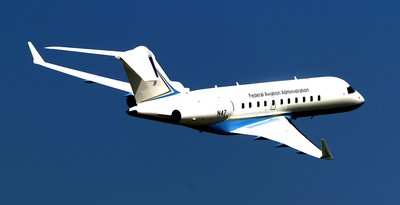Thu, May 12, 2011
Industry's First HUD With Synthetic Vision On Track For
Certification In 2011
A series of flight tests conducted by Rockwell Collins and
Bombardier Aerospace were focused on validating the use of
synthetic vision (SV) on a head-up display (HUD). The goal is to
achieve operational credit for lower landing minima during Special
Authorization (SA) CAT I ILS and WAAS LPV (Wide Area Augmentation
System Localizer Performance with Vertical guidance)
approaches.

Global 5000
The flight tests, performed using a Bombardier Global 5000 test
aircraft equipped with a Rockwell Collins Head-up Guidance System
(HGS), were used to compare varying combinations of flight guidance
symbology with and without SV on both the HUD and the head-down
display (HDD) during ILS approaches. Preliminary results indicate
that ILS tracking accuracy improved 70 percent laterally and 25
percent vertically when SV was displayed on the HUD. Tracking on
the HDD with SV also showed improvement when compared to the HDD
without SV.
"Our ultimate goal is to achieve operational credit for lower
landing minima down to 100 feet, which will result in less
rerouting of flights at hundreds of airports when visibility is
low," said Greg Irmen, vice president and general manager, Business
and Regional Systems for Rockwell Collins. "While more testing is
needed, these initial findings support our philosophy that head-up,
eyes-out is the preferred way to fly and the best approach for
achieving our objective."
In order to achieve lower landing minima for WAAS LPV
approaches, the company plans to use its MultiScan weather radar to
cross-check the vertical solution with respect to the runway. "It
is not a matter of if technology will help pilots reach lower
decision heights when landing, it's a matter of when," said
Irmen.
As a first step, Rockwell Collins and Bombardier Aerospace will
be the first to certify synthetic vision on a HUD as part of its
Pro Line Fusion avionics system on the Global Vision flight deck
later this year. Initially, this will be for increased situational
awareness only.
More News
From 2023 (YouTube Version): Legacy of a Titan Robert (Bob) Anderson Hoover was a fighter pilot, test pilot, flight instructor, and air show superstar. More so, Bob Hoover was an i>[...]
Get The Latest in Aviation News NOW on Instagram Are you on Instagram yet? It's been around for a few years, quietly picking up traction mostly thanks to everybody's new obsession >[...]
Aero Linx: B-52H Stratofortress The B-52H Stratofortress is a long-range, heavy bomber that can perform a variety of missions. The bomber is capable of flying at high subsonic spee>[...]
Altimeter Setting The barometric pressure reading used to adjust a pressure altimeter for variations in existing atmospheric pressure or to the standard altimeter setting (29.92).>[...]
"Knowing that we play an active part in bettering people's lives is extremely rewarding. My team and I are very thankful for the opportunity to be here and to help in any way we ca>[...]
 Classic Aero-TV: Remembering Bob Hoover
Classic Aero-TV: Remembering Bob Hoover ANN FAQ: Follow Us On Instagram!
ANN FAQ: Follow Us On Instagram! ANN's Daily Aero-Linx (05.15.24)
ANN's Daily Aero-Linx (05.15.24) ANN's Daily Aero-Term (05.15.24):Altimeter Setting
ANN's Daily Aero-Term (05.15.24):Altimeter Setting Aero-News: Quote of the Day (05.16.24)
Aero-News: Quote of the Day (05.16.24)



